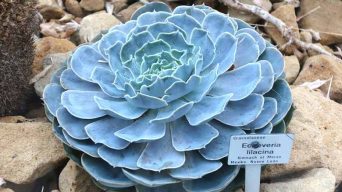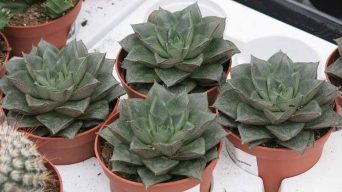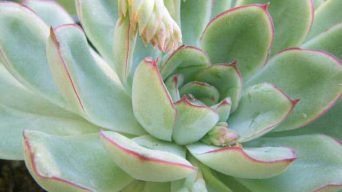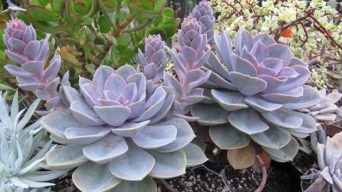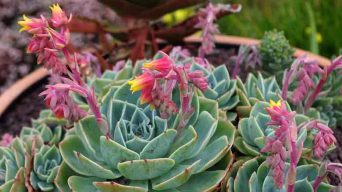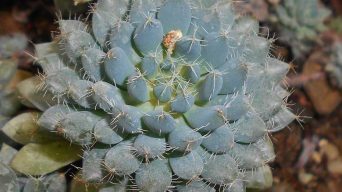Echeveria Elegans is a small but beautiful tight rosette shape succulent that grows to about 8 inches tall.
It has long, pointed green leaves with wavy edges and white flowers.
Echeverias are easy plants to grow indoors or outdoors during the warmer months of the year.
In this article, we’ll show you how to care for your Echeveria elegans as well as how to propagate it!
About the Echeveria Elegans
The Echeveria elegans is a rare succulent found only in specific areas of Mexico.
They’re often called Mexican Snowball, Hens-and-Chicks, or Mexican Gem. They have lovely pink flowers which bloom during late winter and spring.
These plants are related to other types of echeverias, like the popular Rosette Echeveria (Echeveria rosette).
The fleshy leaves on this succulent are more elongated, with bluish hues and copper tips.
How To Care for Echeveria Elegans
Sun Exposure & Light Requirements
Echeveria Elegans can grow in a wide range of exposure levels. However, the most optimal condition for plant growth is bright indirect sunlight or partial shade.
It would be best if you avoided direct sunlight as it will scorch the leaves.
The most preferred location is a warm, sheltered spot in partial shade.
If your plant’s growth becomes stunted from lack of adequate sun exposure, then you can move the pot into an area with brighter indirect sunlight during mid-day hours.
Alternatively, purchase a grow lamp that emits fluorescent light at approximately the same wavelengths as daylight.
Watering Echeveria Elegans
Echeveria plants are considered to be drought-tolerant and require low maintenance. The Echeveria plants also do not require a lot of water to grow healthy.
The Echeveria succulent plant should only be watered every few weeks. Still, it’s best to avoid watering them in the winter months as they are dormant and will not need additional water.
The best way to know if your succulent needs water is by checking the soil. If it doesn’t feel wet, you should probably give your Echeveria plant a good watering session (about an inch of water).
The best time to water this Echeveria type would be in the morning or evening because they are sensitive to sunlight. While there is no right answer for how much time before watering again, one week should do the trick nicely.
Echeveria plants will also need more frequent watering during their growing season, typically between March and September. This is when the sun exposure can cause lower levels of moisture within the soil, so make sure to keep that in mind as well!
Soil
Soil is the most crucial part of any succulent’s care.
Find a potting mix that drains well and provides all essential nutrients to your plants, such as water retention, carbon dioxide supply, and mineral salts.
The best soil type for this plant would be a cactus mix or succulent soil with added perlite because it will drain quickly without staying wet too long.
If you are preparing your own potting mix, mix one-part potting soil with one to two parts perlite and add a handful of coarse sand for drainage.
This will create an ideal environment for succulent plants because they thrive on a well-draining soilless mix.
This type of potting mix holds just enough water to keep the plant hydrated but not too much that it will rot the roots from sitting in dampness. You want happy houseplants!
Temperature and Humidity
Echeveria elegans is an extremely hardy succulent that can withstand a wide range of temperatures and humidity levels.
Generally speaking, these plants do best in moderate-temperature environments with high amounts of light exposure.
Echeveria elegans should never be exposed to extreme heat or cold for extended periods as either one may damage the plant beyond repair.
The optimal daytime temperature for this Echeveria species ranges between 55°F and 75°F, while nighttime lows shouldn’t drop below 45°F (12).
High relative humidity levels are also ideal for Echeveria elegans and should be maintained between 40% and 80%.
Fertilizing Echeveria Elegans
Echeveria elegans don’t require much fertilizer, but it is important to note that they need more as the succulent grows.
The best time of year to give your Echeveria a dose of fertilizer is in early winter or during its summer growing season.
Start by adding a few teaspoons of slow-release organic fertilizer around the base of the plant and then water thoroughly so that it can leech into the soil for maximum absorption.
If you’re looking to get ahead on feeding your plants, add some granulated all-purpose fertilizers in spring when new growth appears and again just before fall’s first frost date.
This will help stimulate healthy root growth while promoting blooming flowers later on down the line.
Potting and Repotting
When you are potting your Echeveria, make sure the soil is well-drained but also moist. If it’s too wet and stays that way for an extended period, then there may be mold or rot in the mix.
The container should have holes at the bottom to allow for drainage.
You can provide extra moisture by misting water from a spray bottle twice daily or placing it near a humidifier if you feel it needs more humidity.
Be careful not to overwater because it can cause root rot and the eventual death of this succulent plant!
If your Echeveria has outgrown its pot, then you can report it.
To do this, remove the plant from its container and loosen the root ball but keep as much of the soil intact as possible to minimize water loss.
Fill a new container with a well-drained, moist mix and place the plant in it so that at least one inch of soil is above the topmost roots.
Pat down gently before watering thoroughly enough to settle all around but not overflow or drip onto surfaces that don’t need wetness, like floors!
Place your succulent where there’s plenty of light without direct sunlight for 12 hours per day and temperatures that are between 50-77 degrees Fahrenheit.
Pruning
Unlike many other succulents, Echeveria elegans plants are slow-growing. They grow to a maximum of 8 inches in height and 12 in width. Thus pruning is not necessary to maintain its size.
But, if you want your houseplant to form a more compact shape and grow in height, pruning is required.
The best time for this process is during summer when the plants are active with new growths or as soon after repotting before new roots have developed.
Cut off at least one-third of the oldest leaves from the stem using clean scissors or a sharp blade without damaging any of the newer ones that may be present on top.
Pruning will not only keep your plant shorter, but it can also help prevent overgrown succulents from becoming leggy and unappealing.
Legginess often leads to brown leaf tips and succulents that may fall easily.
Pests and Diseases
Echeveria elegans are generally not susceptible to pests and diseases. However, they can be attacked by mealybugs or aphids if they are grown in soil that is already infested.
The mealybug covers the plant with cottony wax and can damage new growth but doesn’t usually kill it. Aphids suck sap from plants, leaving honeydew on leaves, eventually becoming black sooty mold.
If an Echeveria has pests or diseases, isolate the damaged succulent to keep it from spreading to other healthy plants.
It would be best to eliminate any infected pots since those may be a source of contamination.
Ensure your hands are clean when handling different types of plants because this will help prevent insects from being introduced into non-infested containers by accident!
Aphids are generally not harmful and can be removed by hand-picking them off the plant.
If your Echeveria elegans plant is infested with mealybugs, you may want to try dish soap and warm water or rub alcohol first before opting for harsher chemicals like insecticides.
How To Propagate Echeveria Elegans Plants
Leaf cuttings or offsets are two ways to propagate an Echeveria elegans succulent easily.
Leaf Cutting
Echeveria Elegans plants can be propagated from leaves.
To propagate an Echeveria elegans, remove a healthy leaf and let it dry for about two weeks before potting up the next generation of succulents.
Place the removed leaf on top of some soil in a small container so that the stem touches the soil but is not buried too deeply.
Gently water your planted leaf every few days with just enough water to saturate the soil’s surface without letting any excess overflow onto other areas or into drains. If you have many cuttings, give them space between each plant.
The cutting will take weeks to root in and then grow.
Once they have grown enough to be removed from their pot, place them in a pot with soil to grow further.
Above all else, remember that Echeveria elegans like company! Use at least two per pot for best results.
Offsets
Offsets will come in the form of small pups that grow on the mother plant. They will grow out of the parent plant and eventually detach from it. Offsets can be easily propagated.
- Look for offsets that grow near the root of the parent plant and detach them from it by pulling the offsets with your fingers or a sharp knife. Make sure to remove any dirt they might have left behind as well during this process.
- After removing an offset, let it dry overnight before putting it up in soil mixes like cactus soil or perlite/vermiculite mixture (50% each). Leave enough space between pups so air circulates around all of them to avoid rot.
- Plant the offset in a small and shallow pot with soil mix and water it.
- When you see new growth on an offset, you will know that its roots have been established. At this point, plant them into their own, larger pots so they can grow bigger, or give them away to friends and family members for free!
Is the Echeveria Elegans Toxic?
There has never been a documented case of any human or animal getting sick from touching the plant.
The only danger associated with this particular succulent is if someone who is allergic to latex rubber touches it and experiences an adverse reaction such as a rash or itchiness.
If you are concerned about allergies, wear gloves when working around your plants so that they don’t contact the skin through touch alone.
This may help keep those sensitive to latex rubber safe while still enjoying their new Echeverias!
Final Thoughts
Echeveria Elegans care is a simple task. This plant requires very little attention and will be an excellent addition to any home or office environment.
Along with their minimal maintenance requirements, they are also low-maintenance plants when it comes to pest control as well!
Plants respond well and grow quickly when cared for properly. It is rewarding to watch your new plant grow into a beautiful specimen.


